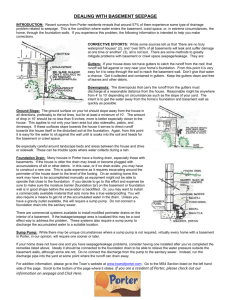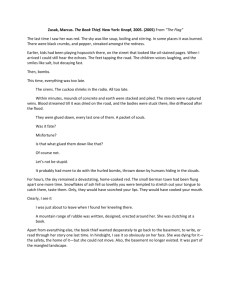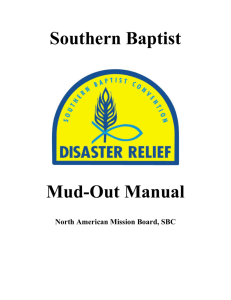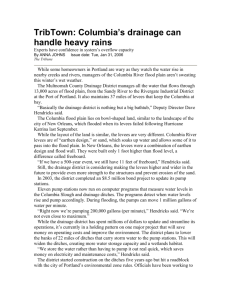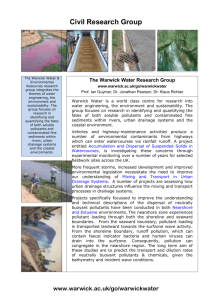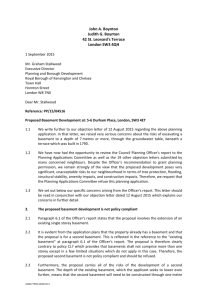Water Problem History There has been a water problem in the
advertisement
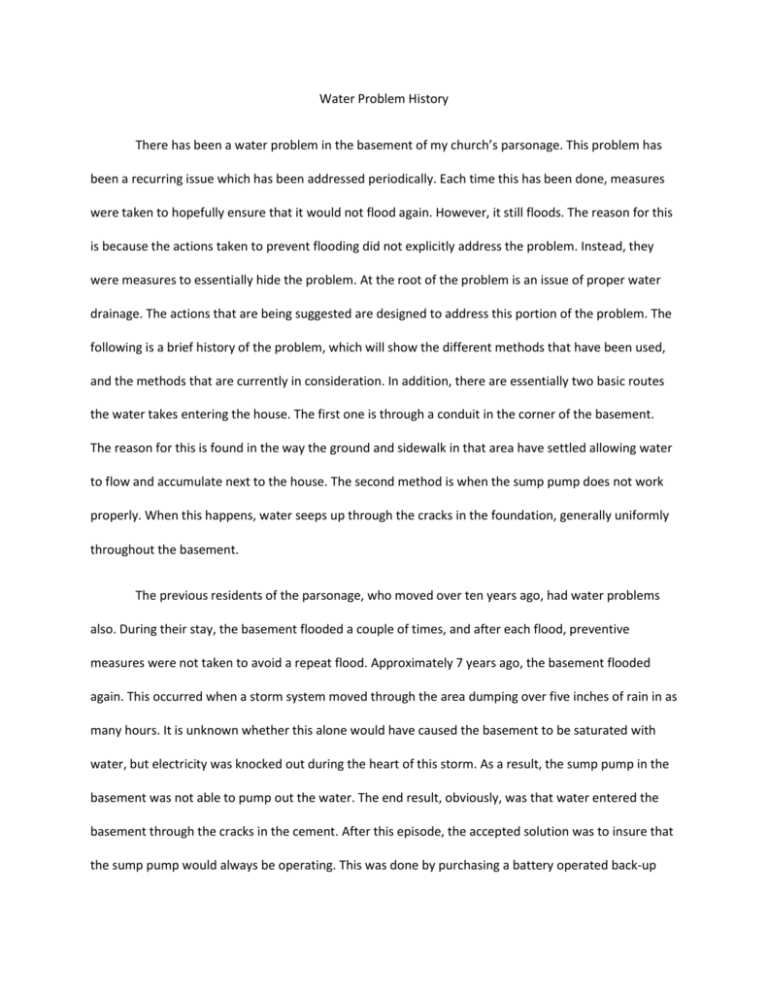
Water Problem History There has been a water problem in the basement of my church’s parsonage. This problem has been a recurring issue which has been addressed periodically. Each time this has been done, measures were taken to hopefully ensure that it would not flood again. However, it still floods. The reason for this is because the actions taken to prevent flooding did not explicitly address the problem. Instead, they were measures to essentially hide the problem. At the root of the problem is an issue of proper water drainage. The actions that are being suggested are designed to address this portion of the problem. The following is a brief history of the problem, which will show the different methods that have been used, and the methods that are currently in consideration. In addition, there are essentially two basic routes the water takes entering the house. The first one is through a conduit in the corner of the basement. The reason for this is found in the way the ground and sidewalk in that area have settled allowing water to flow and accumulate next to the house. The second method is when the sump pump does not work properly. When this happens, water seeps up through the cracks in the foundation, generally uniformly throughout the basement. The previous residents of the parsonage, who moved over ten years ago, had water problems also. During their stay, the basement flooded a couple of times, and after each flood, preventive measures were not taken to avoid a repeat flood. Approximately 7 years ago, the basement flooded again. This occurred when a storm system moved through the area dumping over five inches of rain in as many hours. It is unknown whether this alone would have caused the basement to be saturated with water, but electricity was knocked out during the heart of this storm. As a result, the sump pump in the basement was not able to pump out the water. The end result, obviously, was that water entered the basement through the cracks in the cement. After this episode, the accepted solution was to insure that the sump pump would always be operating. This was done by purchasing a battery operated back-up pump which could run for about eight hours. If the power was out for an extended period of time, a generator was then purchased in order to make sure that the pump would always have a source of power. This seemed like a good solution until June 2008. In June 2008, a series of very strong storms moved through our area and in turn dumped about 8-10 inches of rain in 48 hours. During these storms, the electricity was never out. Because of this, the idea of the basement flooding never came to mind. However, the rain came down so incredibly hard and with the ground already being saturated, the sump pump could not keep up. The result: water came up through the foundation again. This happened twice in the span of three days. At peak time, there was about three inches of water standing in the basement. It has been since this flood that it has become apparent that something needs to be done with the way that the water drains. Normally when looking at how water drains on a residential property would be relatively simple. This is not the case in this instance. The parsonage is located on the same piece of property as the church building and a relatively large, paved parking lot. Possible Solutions? The congregation is currently in the process of figuring out what needs to be done to prevent this reoccurring issue. This is where I have been working, and in the process learning about the ins and outs of water drainage from a member of my congregation who is a civil engineer. Through meeting with him, several potential solutions have been suggested. There are pros and cons to each solution. Some of the solutions are naturally cheaper, but might not be as effective. Others are more expensive, but would almost certainly end the problem. Cost estimates are currently being received for the different scenarios, and will be presented to the Board of Property. One such solution is to change the method of draining the ground water. In the back of the house, there is a hill which ends in a wooded area. Because of the slope of the ground, there might not be much need for a pump. The water would just drain through tiles by using the force of gravity. This would seem to be a good solution since it would not rely on electricity and the mechanics of a pump. In the event of this system not keeping up with the intake of water, a pump could be used to compensate. The only other solution which would take care of the ground water is to install another pump with a duplicate pipe carrying the water away from the house. This way there would be two pumps which could work together to drain the water. Now these two solutions would address the issue of water coming into the basement through the cracks in the cement. It would not, however, address the issue of water pooling around the base of the house where the ground has settled. This would require a separate action. The draining of the parking lot contributes to a large volume of water running off into the area of the building. In order to control this, there are multiple possibilities. One simple, but possibly expensive solution would be to put a curb of some variety along that edge of the pavement. This could then funnel the flow of water so that it would drain down the hill, away from the house. Another related possibility would be to install underground drainage, such as a grate and pipe which drains it underground from the parking lot. This would probably be just as expensive, and could be destructive, so this probably will not be considered. Another solution which should be done either way is to raise the ground and sidewalk around the house or just re-pore the sidewalk on elevated ground. This would then keep the water from using the sidewalk as a method of draining. The only problem is that the elevation of the parking lot is slightly higher than the house’s back entrance. So while this would certainly help, it would not completely eliminate water from wanting to drain that way. The final idea is allowing the water to drain the current way, with the exception of just elevating the soil around the house, and eliminating the grass in some strategic areas and planting rain gardens to absorb the excess water. This portion of the solution would prevent water from seeping into the house. The pros and cons of these are being discussed, and the final solution will probably feature a combination of these ideas, and possibly other ideas will arise as the project is undertaken. Service Learning Tie-In Water drainage, which is the problem that this project addresses, has drawn some attention on larger scales, but can oftentimes be forgotten on the smaller scales. However, it is important that we control it wherever it occurs. Whenever it rains on a large parking lot, the water will pick up whatever is on the pavement at the time and carry it to drainage sewers or onto lakes and rivers. The contents which the water carries could contain residue from motor oil, gasoline, antifreeze, and other automobile pollutants. These then have adverse effects on the ecosystems which these pollutants pass through and reside in. So controlling the drainage of the water reduces the amount of pollutants which are in the watershed. Another way which this can help reduce waste and help the environment is by eliminating the material which is going into landfills due to a basement being repaired after a flood. Landfills are a prime source of pollutants, and the resources and financial costs which go into using landfills are quite high. Therefore, if you can control water from flowing into a basement, the dumping of carpeting, drywall, and miscellaneous goods into the landfills is reduced. Also in preventing the water from going into the sewers, it can either prevent it from backing up at the treatment plan (as in some areas of Milwaukee), or as is the case in this situation, prevents it from be discharged into the Root River. When water is discharged into the Root River, it then can cause flooding elsewhere, which essentially just passes the problem on down to other individuals. The pollutants draining into a watershed and the overuse of landfills both are connected to the impact which something like this could potentially have on other individuals and other locations. First of all, landfills are not something which are usually close by. They tend to be located farther away and in order to get the material to that location, fossil fuels have to be burned for the trucks or other transportation devices used to transport it. This in turn contributes to the pollution in a city. The polluted water can drain into a watershed, and while it might not impact the immediate area, it could possibly impact a river (such as the Root River in this case, or a lake (Lake Michigan). This would then directly impact those in the path of the river or who draw on the fresh water of Lake Michigan. The Be SMART organization, which I worked with on this project, works to reduce the waste produced by society. This is done by encouraging the prevention of wasteful activities. This then means that there is less of a need to use financial resources to help supplement the excessive activities of a community, organization, or individual. This money which is saved can then be used to help the population in any number of ways, whether it is by reducing taxes, cleaning up other pollution problems, or improving the community for the citizens. Essentially Be SMART’s mission is to reduce waste and in turn help prevent pollution before it even begins. While improving the drainage on the church property will reduce waste, and help reduce the pollution which flows into the watershed, it will not be a dramatic effect. In order to have a bigger effect, projects similar to this need to be taking place all across the area. Only then will you see a dramatic improvement in the quality of the resources and the reduction in the pollution. There are however, plenty of reasons why people do not want to create better drainage routes on their property. The biggest reason is the expense. No matter what you do, chances are it will take money, and if nothing else, it will take time. It is also hard for a home owner to necessarily see the effects that are taking place with the improvements. One other reason why this is not done more often is because people do not realize what should be done. As long as they are not too adversely affected by the problem, they do not realize the benefits for spending the energy on this project. While this may be discouraging, it is important to realize that everyone has to do his/her own part, and in this way help keep the environment clean. In a situation like this, it can be used to see the impact that a larger organization or community could have if they took action on a similar, larger problem. Conclusion This project has shown me the many different aspects of how water drainage impacts the environment. Such a project is hard to quantify, and measure actual results, however, the measurements could be made by looking at the reduction of water which drains towards the house. In addition, if the basement does not flood again, then it could also be deemed to be a success. While we can take these measures to improve the drainage, and prevent water from going into the sewer, the end result will not be known until the next strong storm strikes. Wait, I think I hear thunder….. .
